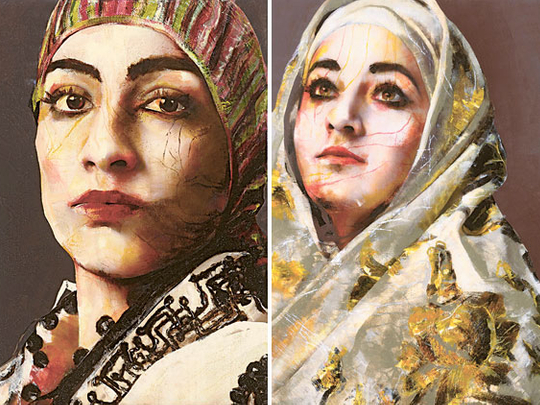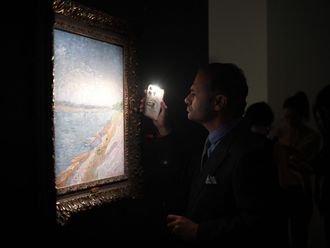
The women in Lita Cabellut's paintings have a distinctly oriental look. Each of them is draped in layers of fabric, and her head and most of her face is covered with a scarf. Yet her portrait tells us so much about who she is and the story of her life. Through the eyes and the body language of the women, Cabellut has captured not only their grace and beauty but also their inner strength, and the feelings and emotions hidden deep within their hearts.
The Amsterdam-based Spanish artist has created these paintings specially for her first solo show in Dubai, titled Memories Wrapped in Gold Paper.
"I am appalled at the growing intolerance in Europe towards traditions such as the wearing of veils by Muslim women. I believe we are defined by the traditions and values that are passed down to us over generations, and if we lose these, we will lose our identity and the essence of who we are. For me, losing our traditions and values is like being naked. This is why the women in my paintings are covered with textiles. The ‘memories' in the title of my show refers to tradition, and I want to wrap it in gold paper because this is our treasure — it must be carefully preserved," the artist says.
Cabellut has emphasised the richness of tradition through the exquisite floral and arabesque patterns she has painted on the fabrics. And she has used the symbolism of butterflies to underline the foolishness of human beings, who have the short lifespan of a butterfly but fight against traditions that have endured over centuries.
The women she has painted come from countries such as Morocco, Saudi Arabia and Syria, but they all live in the Netherlands. "I saw these women on the streets of Amsterdam and asked them to pose for me. But before painting their portraits, I spent time talking to them, because I wanted to go inside their hearts and show the world their inner beauty, fragility and strength.
"Most people have a stereotypical view of women who wear veils, but I wanted to show them that behind the veil, they are no different from other women. They are mothers, daughters and wives who keep our traditions alive," Cabellut says.
A striking feature of her paintings is the cracks and bubbles on her canvases that give the paintings a fresco-like quality. The lines add character to the faces and the bubbles convey a sense of the emotions simmering within. The artist has spent years developing this technique. "I believe the skin is the window to the soul, and wanted to find an effective way to depict this. So I experimented with various materials and techniques and developed a process for preparing a canvas that combines classical techniques of fresco painting and iconographic painting that creates cracks and bubbles. The cracks dictate my composition and tell me how to make the model pose, so they appear in a certain way on her face. The bubbles are like the pores on the skin. For me each crack and bubble is like a window to the many worlds that exist inside the person and allows me to penetrate deep inside the soul of the person," she says.
Although her paintings feature oriental women, the message is meant for Europeans. Two sets of triptychs underline this fact. One set features a Dutch woman, wearing a traditional bonnet. Her eyes are cast downwards and she looks sad and helpless. The other set has a veiled woman whose face is barely visible but she appears strong and confident.
"We criticise women who wear veils, but what about the hundreds of European women who are oppressed and subjected to domestic violence? Why do we form opinions about people based on fabrics? Regardless of whether she wears a veil or not, a woman must be respected, because she is like a monument, built on the strong rock of tradition, and our traditions and values depend on her. Through these paintings I want to protest against what is happening, and create a bridge of peace between cultures," the artist says.
Cabellut's feelings about preserving tradition and identity are especially poignant in the light of her own background. She was an orphan who grew up in the streets of Barcelona before being adopted by a Dutch couple.
"My life was no different from that of millions of street children around the world. But I had the good luck to discover art, which has been my anchor in life. My childhood has made me realise that our identity comes from our traditions, and not having that is a huge loss. It has taught me how important it is to value traditions and to preserve them in gold paper," she says.
Jyoti Kalsi is an arts enthusiast based in Dubai.
Memories Wrapped in Gold Paper will run at Opera Gallery, Dubai, until May 30.











